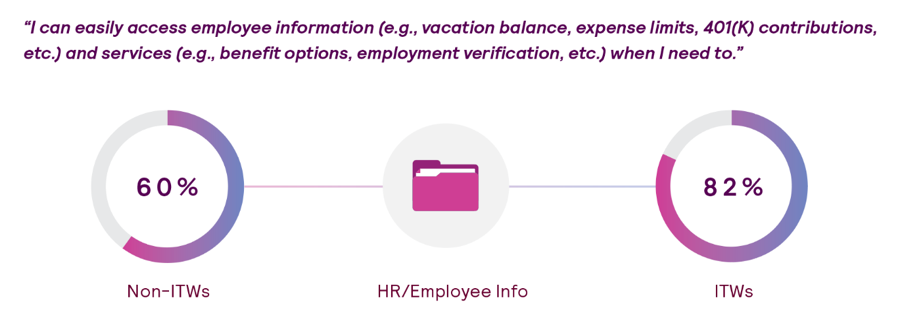To Lead through Disruption, Tech Firms Reinvent HR in the Innovation Era

Job candidates sit in an office, preparing for an interview. A recent Mercer report explored what innovation-driven tech workplaces do differently, especially when it comes to employee experience.
Photo: Shutterstock
Disruptive innovation has become the new normal. For today’s technology organizations that define and deliver disruption, it’s important to create workplaces that inspire, enable and drive innovation — all while serving as talent magnets. With competition for highly skilled talent at an all-time high, the challenge is great.
Some tech companies are better at this than others. A recent Mercer report explored what innovation-driven tech workplaces (ITWs) do differently — especially when it comes to the employee experience. Surveying several hundred tech companies through interviews with executives, five dimensions that set ITWs apart came into focus. These include: an impact-driven vision and culture; a focus on hybrid skills and learning experiences; inclusive people programs and processes; flexible organizational architecture; and digital workplaces.
Indeed, to create innovation-driven tech workplaces, the industry’s people executives may need to reinvent how they approach their jobs. One ITW chief human resources officer (CHRO) said it best: “We as HR leaders need to ask ourselves — What is my role? Is it a general manager? A subject matter expert? A ‘router’? What does the business need?”
The five key dimensions isolated by the Mercer survey suggest that ITWs are, by definition, positioned to reflect and respond to their business needs — and will benefit from HR leadership that understands that. For example, an impact-driven vision and culture is one that rewards customer focus, collaboration, speed and comfort with failure, and enables employees to work on innovative products and services. Technology companies are typically created around such values, but they should never be taken for granted.
Likewise, HR should facilitate the focus on hybrid skills and learning experiences that encourage learning on the job and codify learning through formal and informal channels. This might take the form of exposure to new and experimental software systems or, for example, webinars or informal gatherings that discuss future trends to maintain a sharp awareness of where technology is headed.
Inclusive People Programs
At the same time, the emphasis on innovation, skills and learning must coexist with a commitment to inclusive people programs and processes in order to avoid any structural or systemic bias that may leave some employee groups out. Programs should be flexible, personalized and drive engagement across the enterprise, promoting competitive and inclusive rewards. For example, offsite and contract workers, or even those on extended leave, should be considered when significant opportunities to learn or expand horizons arise.
But such big-picture thinking isn’t necessarily automatic. It’s most likely to thrive with flexible organizational architecture that moves tasks and decisions closest to the relevant information and that rewards innovative behavior and fosters team collaboration and risk-taking. HR leadership needs to look closely at how much flexibility exists within the enterprise.
The crucial context for optimizing these HR dimensions — and, again, an area where technology companies have an advantage — is the digital workplace itself, one that brings together intelligent applications and innovative work practices. It’s one that encourages autonomy, collaboration and human/machine teaming. ITWs are at the forefront of digital workplaces, but maintaining the human dimension is one of HR’s prime challenges.
By now, most HR leaders understand the importance of reinventing operating models and building a digital HR organization. But how to get there? Mercer research uncovered several important areas to consider.
The first is to create innovative people programs and initiatives that focus on experience and impact while eschewing prescriptive processes. Design people initiatives that focus on “moments that matter” for employees. Consider looser job architectures to enable internal career mobility and competitive rewards. To engage a diverse workforce, redesign rewards strategy to address needs and preferences through inclusive benefits.
Next, it’s important to ensure broader business capabilities in HR. Consider new ways of enhancing opportunities for HR talent — rotations, project-based work, digital capabilities and cross-pollination between HR and business competencies in people operations. An ITW CHRO mentioned that it was much easier to build the customer focus in HR by bringing in business talent to drive employee service programs.
Digital HR Strategy
A digital HR strategy leading with technology to improve experience and productivity is vital.
“CHROs have a unique opportunity to optimize, transform and automate the entire employee experience with the help of smart technologies, like AI, data and analytics, and virtual assistants,” observes Mercer chief digital officer Gail Evans. “These enabling technologies, using algorithms, will deliver smart people analytics, frictionless and personalized experience for employees, and remove bias patterns during the recruiting process.”
What’s more, Ms. Evans notes, “This concierge experience will curate personalized learning and enable employees with a 24/7 virtual experience that can provide answers to policy questions and perform scheduling and notification tasks. These technologies enable HR professionals to enrich an employee’s experience with an organization at every step in the talent management life cycle.”
Leveraging digital technologies and analytics can improve operations, reduce back-office roles through automation and improve service quality through outsourcing non-core activities. Ask employees: How easy is it for them to access employee information and services when they need to? ITWs do this much better than the rest of the industry.
They also drive harmonization between centers of excellence and the businesses they support. Consider how a better data-based understanding of the impact to business could benefit the organization. Take into account the employee experience and business value generated through people analytics.
Finally, it’s important to enable a more local, active role for HR business partners, or HRBPs. Empower them to support business leaders by identifying and addressing near-term talent challenges and gaps that need a contextualized solution based on the company’s own experiences. It is easiest to innovate when addressing a pressing business problem, and HRBPs are the closest to the business; they can bring a strong, credible voice to the innovation process.






